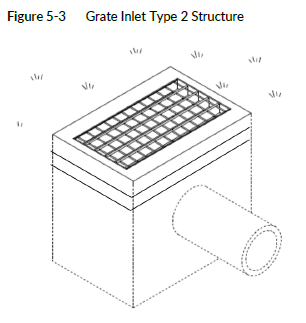WSDOT uses grate inlets, catch basins, and manholes to capture runoff for WSDOT projects. Each inlet structure type has different variations and advantages for use in certain situations. On top of each inlet structure type is a grate that allows water to flow into the structure. This section briefly describes each structure type.
5-5.1.1 Grate Inlet Type 1 Structure: Standard Plan B-35.20-00
Grate inlet Type 1 structures are cast-in-place and use a sump by placing the outlet pipe’s invert elevation higher than the bottom of the structure (Figure 5-2). This allows suspended sediment within the water to settle and reduce turbidity prior to entering the downstream stormwater system. Type 1 inlet structures require more construction because they are cast-in-place; however, this allows the PEO to tie into existing stormwater infrastructure without modifying the hydraulic gradient.
5-5.1.2 Grate Inlet Type 2 Inlet Structure: Standard Plan B-35.40-00
Grate inlet Type 2 structures are constructed using sections of precast reinforced concrete (Figure 5-3). These precast sections can be stacked to meet the required height, thus reducing construction time and cost. This inlet structure is similar to grate inlet Type 1 in that they both have an invert elevation higher than the structure bottom. This creates a sump that allows suspended sediment to settle prior to entering the downstream stormwater system. The grate inlet Type 2 should be used in areas where existing infrastructure is easy to tie into.
5-5.1.3 Catch Basins
Catch basins are designed to retain sediment and debris transported by stormwater into a storm sewer system. Catch basins include a sump for collection of sediment and debris. Catch basin sumps require periodic cleaning to be effective and may become an odor and mosquito nuisance if not properly maintained. Catch basins are used to link long runs of storm sewer pipes and to help change directions of the storm sewer system. See the following:
• Standard Plan B-5.20-03 Catch Basin Type 1
• Standard Plan B-5.40-02 Catch Basin Type 1L
• Standard Plan B-5.60-02 Catch Basin Type 1P (for Parking Lot)
• Standard Plan B-10.20-02 Catch Basin Type 2
• Standard Plan B-10.40-02 Catch Basin Type 2 with Flow Restrictor
• Standard Plan B-10.70-02 Catch Basin T-PVC
Within WSDOT ROW, a T-PVC catch basin can be used as an inlet or as a junction box in locations not subject to traffic loading such as ditches, landscaped or vegetated areas, and separated pedestrian paths. The use of a T-PVC catch basin requires the approval of the State Hydraulics Office through the RHE. The RHE shall not recommend approval without first getting concurrence from Region Maintenance. If approved for installation, T-PVC catch basin shall not be connected to a drainage system that is fully or partially installed within a roadway, sidewalk adjacent to the roadway, and the paved surface of a rest area.
5-5.1.4 Manholes
Similar to catch basins, manholes are to convey stormwater as a part of a storm sewer system. They are used to also change the direction of a storm sewer system. Manholes do not have a sump. They can have solid locking lids that block water from entering the manhole. They can also be configured to have a grate to allow water to flow into the manhole. See the following:
• Standard Plan B-15.20-01 Manhole Type 1
• Standard Plan B-15.40-01 Manhole Type 2
• Standard Plan B-15.60-02 Manhole Type 3
5-5.1.5 Concrete Inlet: Standard Plan B-25.60-02
A concrete inlet is used when a sump to catch sediments is not desired and the maximum inside pipe diameter is less than or equal to 15 inches.

